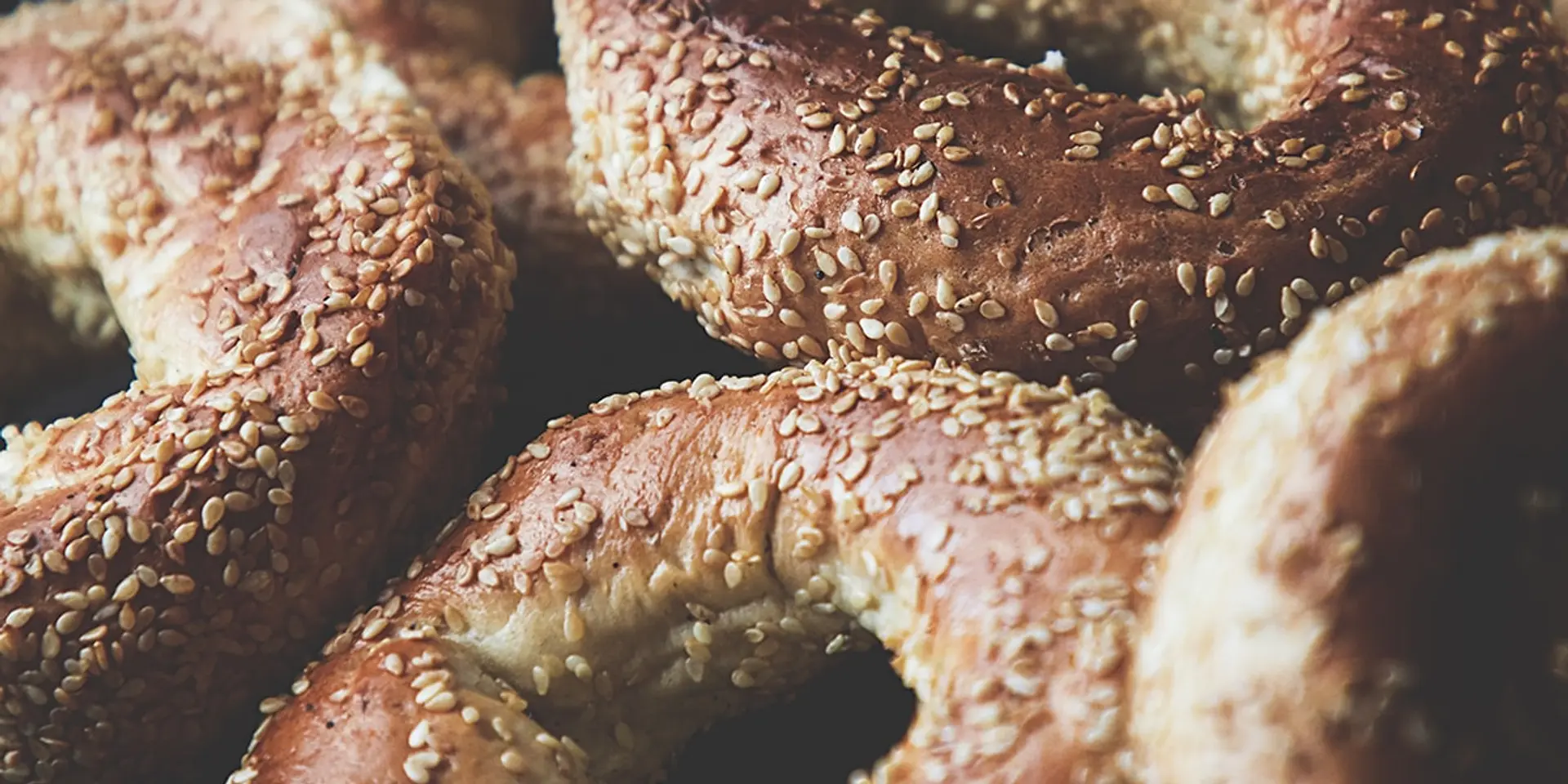Bagels are a type of bread that is boiled before it is baked. This gives the bagel a chewy texture. Bagels are often topped with seeds or spices and can be served plain, with cream cheese, or as a sandwich.
What are Bagels?
Updated:

"Bagels Bread" by Foodie Girl is marked with CC0 1.0. To view the terms, visit https://creativecommons.org/publicdomain/zero/1.0/?ref=openverse.
Table of Contents
There’s an old story that King Jan Sobieski of Poland invented the bagel in 1683, but there is evidence of the raised bread dating back to the 14th century.
History considers bagels as an ethnically Jewish dish and did not gain popularity in the U.S. until the late 19th century.
The distinctive features of the bagel, its slightly spongy texture, and crisp edges that yield to a soft bite are in part what makes it so popular.
Bagels are made from a raised bread dough. Most bagels are made with a sweetener to feed the yeast, like honey or sugar.
Bagels require proofing of around 12 hours to achieve the firm, yet chewy texture of a traditional bagel.
Contrary to most bread types, bagels are traditionally boiled instead of baked, though they are often baked at 315 degrees.
The History of Bagels
Of all the breakfast bread in the world, there is none more satisfying than a bagel. The bagel, slathered in butter or cream cheese has been a breakfast favorite for a century in the United States, but the chewy bread has been a staple for any meal since before the 14th Century.
The story goes one of two ways. The first declares the bagel to be the invention of Poland, loved by a certain Queen Jadwiga who loved to eat the obwarzanki bagel during Lent during her 14th-century reign.
However, Austria contests Poland’s claim to inventing the bagel.
The Austrians declare the bagel, or beugel, the invention of a Viennese baker paying tribute to King Jan Sobieski of Poland. The Austrian beugel is reportedly shaped like a stirrup to commemorate King Sobieski’s defending of Austria in war.
Coincidentally, or not, the word beugel translates to “stirrup” and is the most likely source for the modern bagel’s name. Today’s bagels came to the United States during the 19th Century.
They gained popularity in the 1970s as ethnic foods became the new “in” food.
In the 1970s the bagel began to evolve into a sweeter, softer bread. As machinery became more advanced, bagels became more uniform in shape, and flavor options became more diverse. Chocolate chips, cheese, seeds, nuts, and herbs were easily added to the bagel.
After the bagel, or the “Jewish English-muffin” grew in popularity, there was no going back.
When did bagels become popular?
Jewish quarters of New York, Chicago, and California made the bagel famous, and now bagel vendors line streets in the cities, and you can find them in any grocery store across the country!
Ingredients in Bagels
Bagels consist of five main ingredients.
- Egg
- Salt
- Flour
- Greek Yogurt
- Baking Powder
The sixth ingredient is one not found on grocery store shelves: time.
Bagel Nutritional Information
The nutritional content of bagels varies depending on flour-type, but the average plain bagel recipe has low levels of saturated fat and cholesterol and no sugar.
However, common variations of bagels include sugar, spices, cheeses, or additional ingredients that change the nutritional content.
Common variations that include seeds, fruits, or berries are higher in sugar, but also contain Vitamin C, healthy fats, thiamin, and sodium.
Selections with cheese, meat, or seeds provide more protein.
A medium-sized, plain bagel of around 100 grams will contain the following :
Approx values based on a 100g portion.
How to make Bagels
Bagels aren’t hard, but they are time-consuming. You’ll want to think of bagels as a 2-day affair.
The preparation phase and proofing (or raising) of the bagels take up day one, with the proofing ending on day two when the baking of the bagels ensues.
A typical bagel recipe done in the traditional sense follows the traditional bread-making steps of mixing, kneading, and proofing.
However, bagels require more than one proofing step.
The first step occurs just after mixing and kneading and the second follows the all-important step of shaping the dough.
After achieving the circular shape of the bagel, the dough proves over the course of 24 to 48 hours.
Unlike most bread types, bagels are not just baked in the oven. Bagels are first boiled before baking, which toasts the bagel.
You boil bagels once they are able to float in a bowl of cold water and are then baked after being boiled.
Bagel Recipes
There is nothing quite like eating a plain bagel toasted and slathered with cream cheese. The beloved classic has since evolved into a myriad of delicious variations that can be found in bakeries and stores everywhere.
Some common variations include savory renditions like the oh-so-loved “everything” bagel topped with such yummy ingredients as poppy seeds, pepper, onion, garlic, or sesame seeds, though every vendor has their own twist on the classic.
Or, if you have a sweet tooth, consider trying a “cinnamon sugar” bagel topped with a crunchy layer of the ingredients in its name, or sample a blueberry bagel for a fruity twist on the classic.
The sky is the limit when it comes to bagels. The basic dough, delicious all on its own, adapts to just about any savory or sweet ingredient that comes to mind!
Bagel FAQ's
Bagels are thought to have originated in Poland. They were brought to the United States by Jewish immigrants in the late 19th century.
Bagels are made by boiling a doughnut-shaped piece of bread in water or steam. This creates a chewy texture. The bagel is then baked in an oven.
Bagels are typically made with a high-gluten flour. This type of flour has more gluten, or protein, than other types of flour. This gives the bagel its chewy texture.
No, not all bagels are round. Some bagel shapes include: oval, twist, flat, and onion.
A plain bagel typically has around 240 calories. Bagels with toppings such as cream cheese or nuts can have more calories.
Bagels are made with flour, water, and yeast. This combination does not contain any unhealthy fats or additives. However, bagels are often high in calories because of the toppings they contain.
Bagels are best eaten the day they are made. However, they can be stored in a bag or container for up to 3 days. After that, the bagel will start to stale and become harder.
Yes, you can freeze bagels. Bagels can be stored in the freezer for up to 3 months. When you are ready to eat the bagel, thaw it at room temperature or in the microwave.
A bagel sandwich is a sandwich made with a bagel instead of bread. Bagel sandwiches can be made with any type of filling, such as: cream cheese, peanut butter, jelly, or meats.
Bagels can be eaten plain or with toppings. Bagels are often sliced in half and then topped with cream cheese, peanut butter, jelly, or meat.
A bagel with a hole in it is called an "open-faced" bagel. Open-faced bagels are typically served with cream cheese or peanut butter on top.
An everything bagel is a type of bagel that is topped with a variety of seeds and spices. Some of the common toppings on an everything bagel include: sesame seeds, poppy seeds, garlic, and onion.
A bagel bite is a small piece of bagel that has been topped with cheese and other ingredients. Bagel bites are often served as appetizers or snacks.
A bagel with cream cheese is called a "bagel sandwich." Bagel sandwiches can be made with any type of bagel, but are typically made with plain or everything bagels.
A plain bagel is a type of bagel that does not have any toppings. Plain bagels can be eaten plain or with toppings, such as: cream cheese, peanut butter, jelly, or meat.
A toasted bagel is a bagel that has been heated in an oven or toaster. Toasted bagels are often served with butter or cream cheese.
A bialy is a type of bagel that is native to Poland. Bialys are typically smaller and denser than other types of bagels. They are usually topped with onions and poppy seeds.
A pumpernickel bagel is a type of bagel that is made with rye flour. Pumpernickel bagels are typically darker in color and have a sweeter flavor than other bagels.
A blueberry bagel is a type of bagel that is made with blueberries. Blueberry bagels are often served with cream cheese or jelly.
It's known to be King Jan Sobieski of Poland who invented the bagel in 1683
